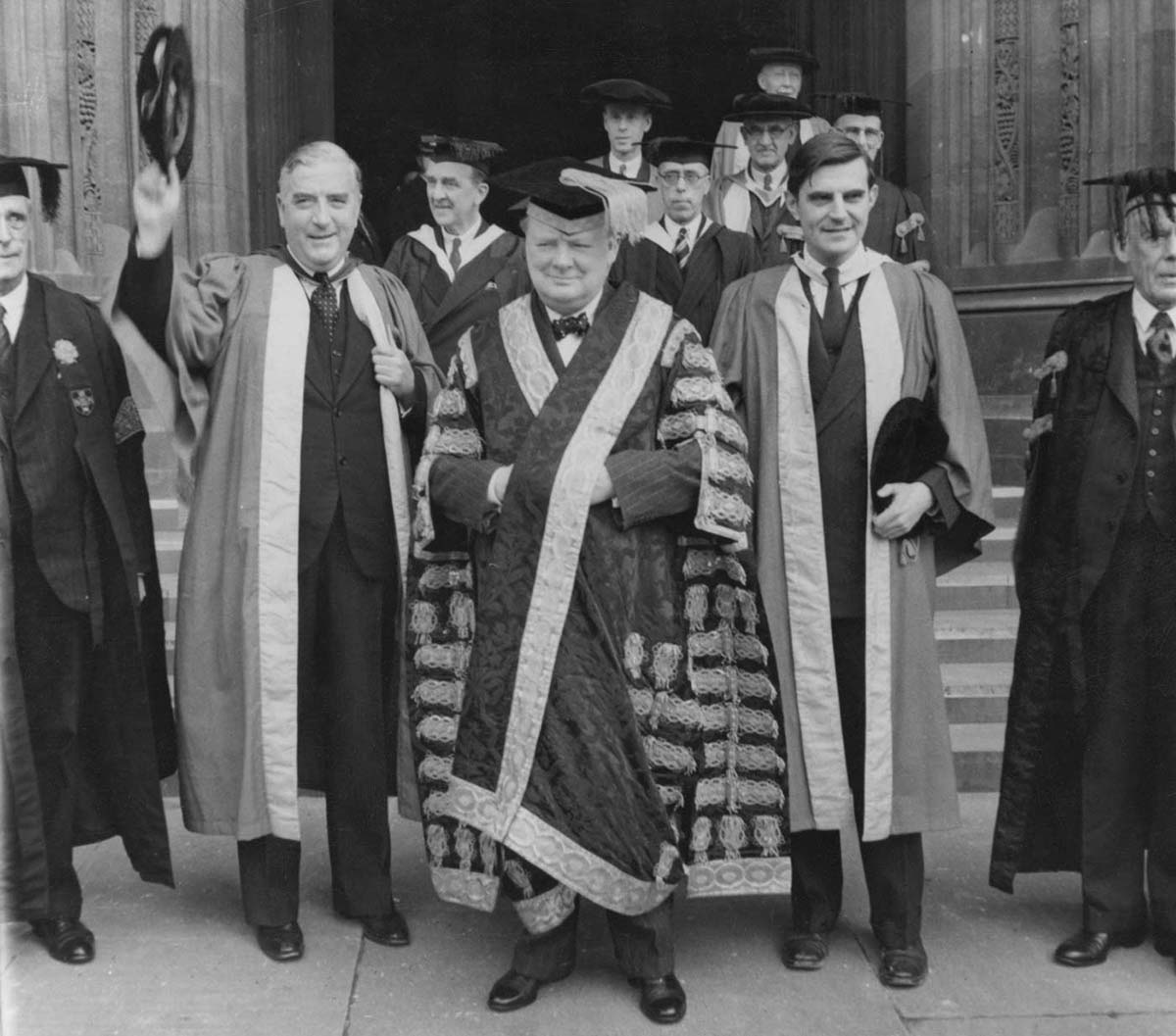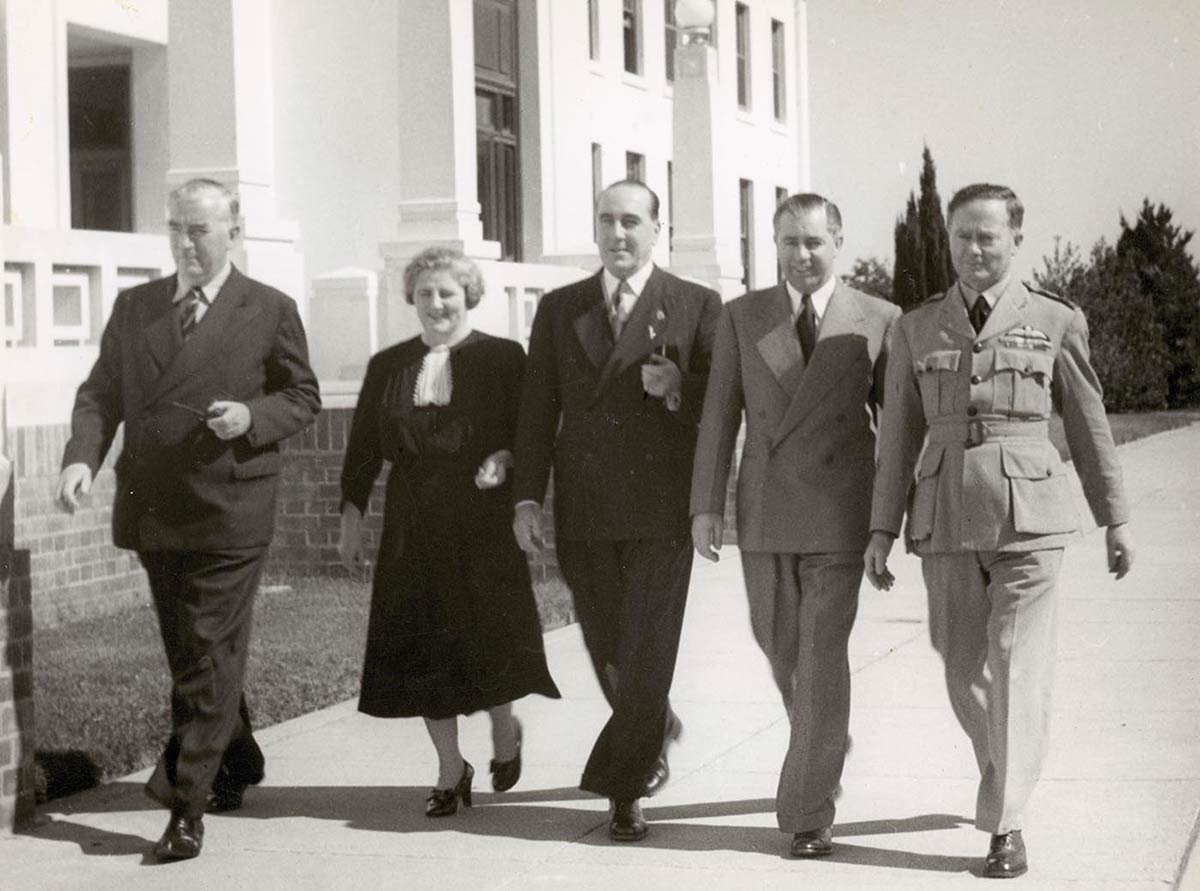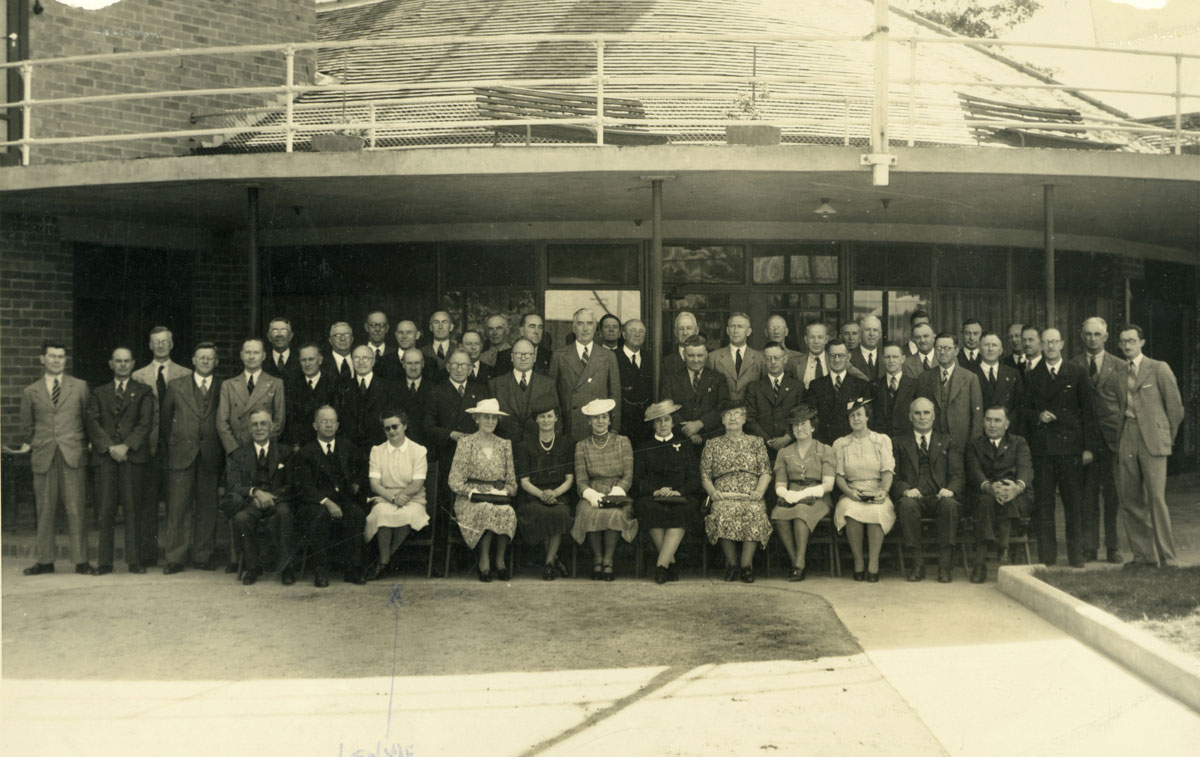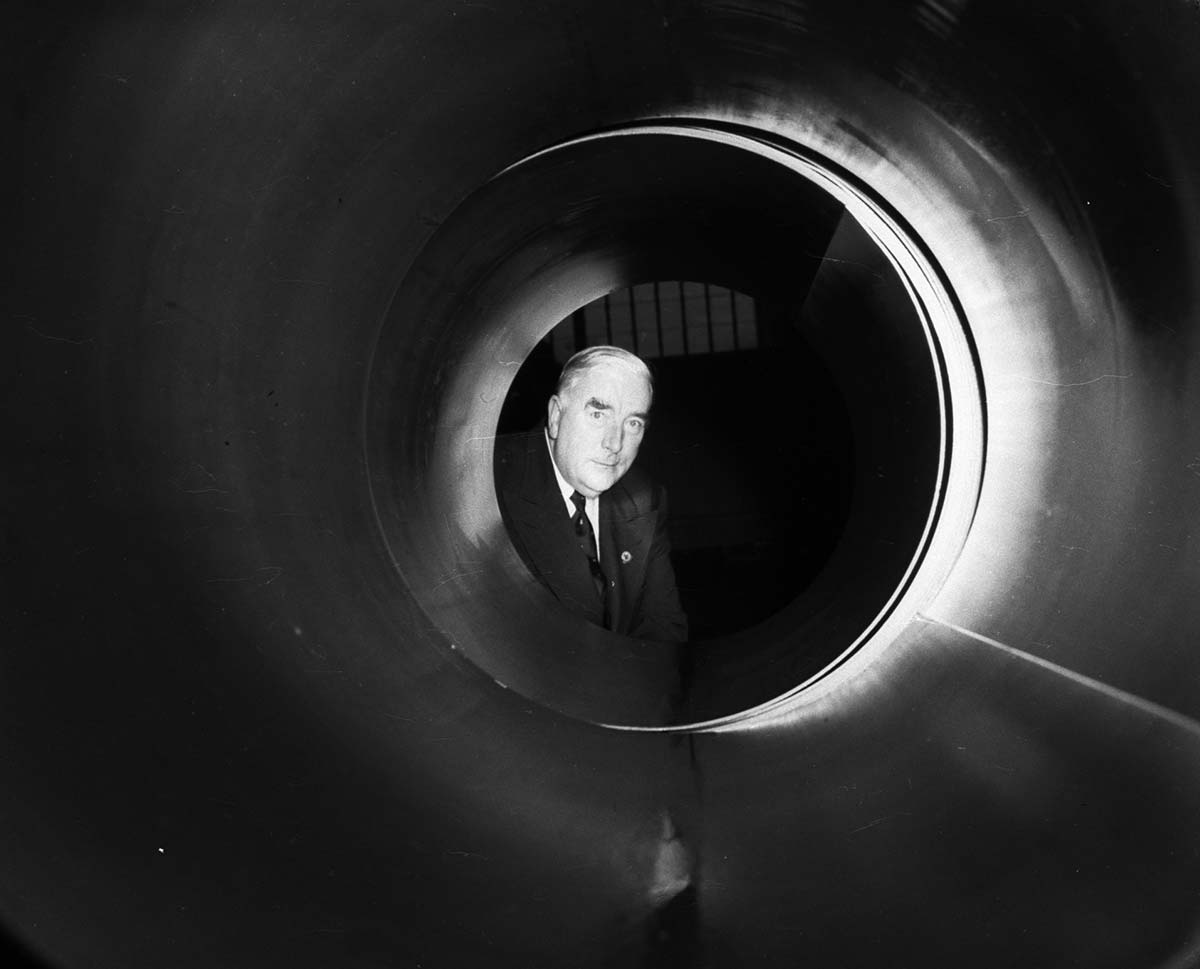Australia’s Prime Minister two times
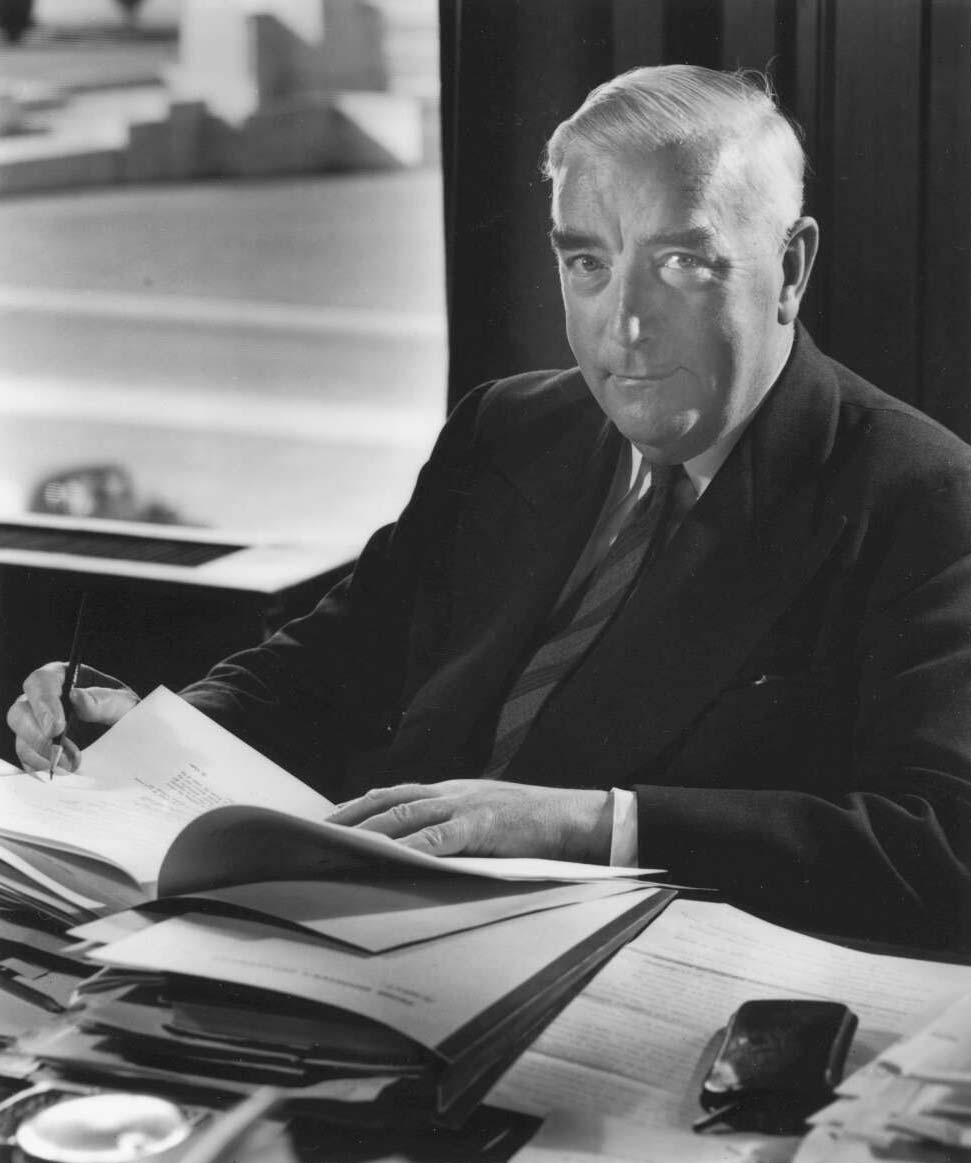
26 April 1939 to 29 August 1941, 19 December 1949 to 26 January 1966
Robert Menzies – ‘Bob’ Menzies or Mr Menzies – was Australia’s longest-serving Prime Minister. He was Prime Minister twice: from 1939–1941, and from 1949–1966, spending a total of 18 years and five months in the position.
Early in his first period in office, he announced the declaration of the Second World War to the people of Australia.
In 1944 he helped found the Liberal Party, which in terms of winning elections has been the most successful party in Australian federal politics.
He presided over Australia’s longest period of prosperity and rising living standards this century.
Menzie's beginnings
Robert Gordon Menzies was born in Jeparit, Victoria, on 20 December 1894. His parents were James Menzies and Kate Sampson.
James, of Scottish descent, had been a coach painter in Ballarat before opening a general store in Jeparit. Kate, of Cornish descent, was the daughter of a miners’ union leader. James was elected to the Victorian parliament in 1909 as the representative for Lowan.
Robert Menzies began his education at Jeparit State School before attending Grenville College, Ballarat, and then Wesley College, Melbourne, as a scholarship student. After an outstanding academic career at the University of Melbourne, he graduated with first class honours in Law in 1917.
He was admitted as a barrister in 1918 and built up a highly successful practice. He married Pattie Maie Leckie in 1920, and they had three children together. In 1929 he became a King’s Counsel, the youngest in Victoria.
Menzies was elected to the Victorian state parliament as a Nationalist Party candidate for the Legislative Council seat of East Yarra in 1928; then resigned and was elected for the Legislative Assembly seat of Nunawading in 1929.
He served as Honorary Minister 1928–1929, Attorney-General and Minister for Railways 1932–1934, and Acting Premier in 1934. He quit state parliament in 1934 to contest the federal seat of Kooyong as a United Australia Party (UAP) candidate.
Menzies' entry into federal politics
After winning the federal seat of Kooyong, Menzies immediately became Attorney-General and Minister for Industry in Joseph Lyons’ United Australia Party government. He held these positions until March 1939, and was also deputy UAP leader from 1935.
He resigned from Cabinet in March 1939 in protest against the government’s failure to implement its national insurance scheme.
Prime Minister Robert Menzies
First prime ministership, 1939–1941
Menzies was elected Leader of the UAP and became Prime Minister in April 1939, following the death in office of Lyons, and after the 18-day caretaker prime ministership of Country Party leader, Earle Page.
He suffered an immediate ferocious attack in parliament from Page, who had favoured the recall to parliament of former Prime Minister Stanley Melbourne Bruce.
Page bitterly accused Menzies of disloyalty to Lyons and the government, and suggested he had been a coward for choosing not to serve overseas during the First World War, although he was a lieutenant in the Army Reserve. (Menzies said his first loyalty was always to the people of his electorate, and maintained that he had family reasons for not serving overseas, as two of his brothers had done.) Refusing to work with Menzies, Page took the Country Party out of coalition with the UAP.
As Prime Minister, Menzies announced the declaration of war against Germany on 3 September 1939. He formed a war cabinet on 15 September and oversaw Australia’s entry into the Second World War.
The Country Party re-entered a coalition with the UAP in March 1940, but losses to Labor at the general election in September severely weakened the Menzies coalition government. Continuing dissension with the coalition prompted Menzies to resign as UAP leader and Prime Minister on 28 August 1941.
Country Party leader Arthur Fadden replaced Menzies as Prime Minister, but held office for only 40 days before being defeated in parliament, making way for John Curtin’s Labor government on 7 October. Despite the instability in the coalition and his loss of office, Menzies had led a government which prepared the nation for war as well as its limited resources allowed.
Menzies was re-elected UAP leader and became Leader of the Opposition in September 1943. In October–December 1944 he sponsored the formation of a new party, the Liberal Party, combining the UAP and 17 other non-Labor groups. He was subsequently elected Liberal leader.
Second prime ministership, 1949–1966
Following increasing public dissatisfaction with Joseph Benedict Chifley’s Labor government, the Liberal and Country parties swept to power at the general election on 10 December 1949.
The fall of Chifley’s Labor government followed a series of Communist-inspired strikes, controversies over Labor’s wish to nationalise private banks, medical practitioners, transport and communications, and mounting public impatience with continuing wartime austerity measures.
Shaking off an earlier reputation for disdain of the public, Menzies proved to be a highly effective populist campaigner, appealing to ordinary citizens through slogans such as ‘Put value back in the pound’ and ‘Are the people the masters of government or government the masters of the people?’
By exchanging electoral preferences, the Liberals won 55 seats and the Country Party 19, to Labor’s 47.
The Liberal and Country parties formed a coalition government on 19 December 1949 with Menzies as Prime Minister and Country Party leader AW Fadden as Deputy Prime Minister.
Menzies’ comeback as Prime Minister after the humiliating circumstances of his resignation from the position eight years previously was a great personal triumph. Menzies led the Liberal–Country Party coalition to victory at the next six general elections: in 1951, 1954, 1955, 1958, 1961 and 1963.
The Menzies agenda
Menzies’ coalition government pursued various initiatives of the former Chifley Labor government, including development of the Snowy Mountains Scheme, mass immigration, and the Colombo Plan for aiding developing nations of the Commonwealth. Otherwise it set its own agenda.
The history of the Snowy Mountains Hydro Scheme in live-sketch animation, as told by historian David Hunt
A key policy was to stamp out Communist influence in the union movement and end disruption caused by strike action; goals to be achieved by abolishing the Communist Party. Parliament passed the Communist Party Dissolution Act in October 1950.
The Act was immediately challenged in the High Court by 10 trade unions, Labor’s deputy leader HV Evatt representing one of these. The Act was declared invalid in March 1951. Menzies then sought power to outlaw the Communist Party through a referendum in September 1951.
Evatt successfully led a campaign for a ‘No’ vote to deny government such powers. The referendum on government power to ban the Communist Party occurred in a climate of mounting Cold War tension between Western and Soviet power blocs.
Menzies’ government sent Australian armed services to the Korean War between 1950–1953 and signed the ANZUS treaty with USA and NZ in 1951, which became the basis of Australian defence planning for the next four decades.
Economic prosperity
The Menzies government presided over the longest period of economic prosperity in Australia’s history, lasting from the late 1940s to the early 1970s. This period was one of rapid development, almost continual economic growth, rising standards of living and very low (below two per cent) unemployment rates.
Two major public spectacles of the mid-1950s became the focus of national attention, prompting outpourings of national sentiment – the Royal Tour of Queen Elizabeth II and Duke of Edinburgh in 1954 and the Melbourne Olympic Games in 1956.
Both events were strongly promoted by the government. Menzies’ position was also strengthened by a split in the Labor Party during the 1950s.
From the mid-1960s the ‘long boom’ continued with the discovery and exploitation of new mineral and petroleum resources.
International presence
During the late 1950s and early 1960s the Menzies government laid the foundations for the subsequent rapid growth of Australia’s university system and began providing financial support to non-government schools.
As well as being Prime Minister, Menzies at different times held other ministerial and acting ministerial positions. His portfolios included Defence Coordination, Information, Trade and Customs, External Affairs, External Territories, Treasury, Attorney-General and responsibility for the Commonwealth Scientific and Industrial Research Organisation (CSIRO).
During his second period as Prime Minister, Menzies’ principal political adversaries were Dr HV (‘Bert’) Evatt (1894–1965), Labor leader from 1951–1960, and Arthur Calwell (1896–1973), Labor leader from 1960–1967.
Menzies' life beyond politics
Menzies travelled widely in Australia and overseas on government business. Apart from frequent trips to the UK, USA and Commonwealth nations (New Zealand, Canada, South Africa, India, Pakistan, Singapore and Malaysia), he visited numerous countries in Europe and Asia for conferences on international relations, trade and defence matters. As such, he played an important ambassadorial role on behalf of both Australia and the Commonwealth of Nations.
One particularly important excursion abroad was his trip to Cairo in September 1956 as head of a five-nation delegation mediating in the Suez crisis. Menzies’ mission failed, and many commentators regarded his intervention as a fiasco.
The commitment of the Menzies government to its alliances with the UK led to the establishment of UK nuclear weapon testing facilities in Australia. The test program continued from 1952–1963.
An increasingly close alliance with the USA resulted in the establishment of American military communications bases in the 1960s as well as other defence and science installations.
From 1962 the Menzies government sent military observers and then troops, including conscripts, to Vietnam to assist the South Vietnamese government and US military forces in the war against the Communists.
A devoted royalist, during his second period as prime minister Menzies received numerous honours and awards, including the imperial titles Companion of Honour (1951), Knight of the Thistle (1963), Lord Warden of the Cinque Ports (1965), and Chief Commander US Legion of Merit (1950), as well as 20 honorary doctorates.
He resigned from the prime ministership in January 1966, passing the position to Harold Holt, the Liberal’s deputy leader, and resigned from parliament in February 1966.
His total of 18 years as Prime Minister, and his unbroken 16-year tenure of office during his second period in the position is the longest of all Australian Prime Ministers. His second period as Prime Minister has remained an inspiration to Liberal Party members.
Menzies' later years
Robert Menzies devoted himself to authorship in retirement. His publications included two books of memoirs: Afternoon Light (1967) and The Measure of Years (1970).
Menzies died in Melbourne on 15 May 1978 and was given a state funeral.
Legislation passed under Menzies
1939–1941
The most important new legislation resulted from the need to put Australia on a war footing. This legislation included:
- The Supply and Development Act 1939 to set up the Department of Supply to organise purchase and manufacture of arms and munitions.
- The National Security Act 1939 and 1940 to give power to the government to make regulations for ‘general safety and defence of the Commonwealth’. This law could be extended to cover almost any activity, but was sometimes successfully challenged in the courts.
- The Aliens Registration Act 1939 to control the movement of foreigners in Australia.
- The National Registration Act 1939 to set up a registry of men liable for military service and to help mobilisation.
- The Trading with the Enemy Act 1939 to prohibit trade with countries at war with Australia.
1949–1965
- The Communist Party Dissolution Act 1950 declared illegal and dissolved the Communist Party and affiliated bodies, but was declared invalid by the High Court in 1951.
- The Conciliation and Arbitration Act 1951 provided for the use of secret ballots in trade union elections.
- The Security Treaty (Australia, New Zealand and the United States of America) Act 1952 provided parliamentary approval of the ANZUS pact.
- The Defence (Special Undertakings) Act 1952 facilitated British nuclear tests at the Monte Bello islands off the coast of Western Australia and later at the Emu and Maralinga sites in South Australia.
- The National Health Act 1953 consolidated medical, hospital, pharmaceutical and pensioner medical services.
- The Broadcasting and Television Act 1956 gave the ABC the same powers in television as it already had in radio, and made other arrangements for the introduction of television.
- A separate industrial court was established under an amendment to the Conciliation and Arbitration Act.
- Various banking acts, including the Reserve Bank Act 1957, which separated central banking from other functions, had been blocked in the Senate during the twenty-second parliament but became Acts of the twenty-third parliament when the Menzies government obtained a majority in the Senate at the 1958 election.
- The Matrimonial Causes Act 1959 provided for uniform divorce laws rather than the ten codes then existing.
- The Telephonic Communications (Interception) Act 1960 (since replaced) established the procedures by which ASIO could tap telephones in order to protect the Commonwealth from acts of espionage or subversion, and the Crimes Act 1960 redefined the offences of treason, sabotage and espionage.
- The National Library Act 1960 established a National Library separate from the Parliamentary Library.
- The Commonwealth Electoral Act 1962 removed the franchise prohibition existing in Queensland, Northern Territory and Western Australia against Aboriginal people in Commonwealth elections.
- The Papua New Guinea Act 1963 was a response to the United Nations Trusteeship Council’s criticism of Australian policy in Papua New Guinea and provided for an enlarged legislature with a majority of indigenous members.
- The Currency Act 1963 prepared for the introduction of decimal currency in 1966.
- The United States Naval Communication Station Act 1963 approved the agreement to establish a communications station at North West Cape in Western Australia.
- The first year of the twenty-fifth parliament, 1964, saw a record 130 bills enacted. The figure for the following year was 156.
- The National Service Act 1965 was a response to Australia’s increasing involvement in the Vietnam War.
In our collection
In our collection
In our collection
